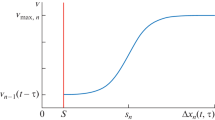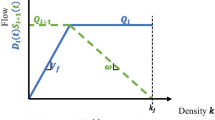Abstract
Traffic modeling is a key step in several intelligent transportation systems (ITS) applications. This paper regards the traffic modeling through the enhancement of the cell transmission model. It considers the traffic flow as a hybrid dynamic system and proposes a piecewise switched linear traffic model. The latter allows an accurate modeling of the traffic flow in a given section by considering its geometry. On the other hand, the piecewise switched linear traffic model handles more than one congestion wave and has the advantage to be modular. The measurements at upstream and downstream boundaries are also used in this model in order to decouple the traffic flow dynamics of successive road portions. Finally, real magnetic sensor data, provided by the performance measurement system on a portion of the Californian SR60-E highway are used to validate the proposed model.
Similar content being viewed by others
References
G. Gomes, R. Horowitz, A. A. Kurzhanskiy, P. Varaiya, J. Kwon. Behavior of the cell transmission model and effectiveness of ramp metering. Transportation Research Part C: Emerging Technologies, vol. 16, no. 4, pp. 485–513, 2008.
N. Messai, P. Thomas, A. El Moudni, E. Leclercq, F. Druaux, D. Lefebvre. Feed-forward and RTRL neural networks for the macroscopic traffic flow prediction and monitoring: The potential of each other. In Proceedings of IEEE International Conference on Intelligent Transportation Systems, IEEE, Shanghai, China, pp. 99–204, 2003.
B. L. Smith, M. J. Demetsky. Traffic flow forecasting: Comparison of modeling approaches. Journal of Transportation Engineering, vol. 123, no. 4, pp. 261–266, 1997.
B. Williams, P. Durvasula, D. Brown. Urban freeway traffic flow prediction: Application of seasonal autoregressive integrated moving average and exponential smoothing models. Transportation Research Record: Journal of the Transportation Research Board, vol. 1644, pp. 132–141, 1998.
B. Ghosh, B. Basu, M. O’Mahony. Multivariate shortterm traffic flow forecasting using time-series analysis. IEEE Transactions on Intelligent Transportation Systems, vol. 10, no. 2, pp. 246–254, 2009.
W. Burghout, H. N. Koutsopoulos, I. Andreasson. A discrete-event mesoscopic traffic simulation model for hybrid traffic simulation. In Proceedings of IEEE Intelligent Transportation Systems Conference, IEEE, Toronto, Canada, pp. 1102–1107, 2006.
A. Gning, L. Mihaylova, R. K. Boel. Interval macroscopic models for traffic networks. IEEE Transactions on Intelligent Transportation Systems, vol. 12, no. 2, pp. 523–536, 2011.
C. F. Daganzo. The cell transmission model: A dynamic representation of highway traffic consistent with the hydrodynamic theory. Transportation Research Part B: Methodological, vol. 28, no. 4, pp. 269–287, 1994.
G. Gomes, R. Horowitz. Optimal freeway ramp metering using the asymmetric cell transmission model. Transportation Research Part C: Emerging Technologies, vol. 14, no. 4, pp. 244–262, 2006.
J. Lee, S. Song. Modeling urban transportation systems with hybrid systems: An overview. In Proceedings of IEEE International Conference on Intelligent Transportation Systems, IEEE, Shanghai, China, pp. 1269–1272, 2003.
P. Redhu, A. K. Gupta. Effect of forward looking sites on a multi-phase lattice hydrodynamic model. Physica A: Statistical Mechanics and its Applications, vol. 445, pp. 150–160, 2016.
P. Redhu, A. K. Gupta. Delayed-feedback control in a lattice hydrodynamic model. Communications in Nonlinear Science and Numerical Simulation, vol. 27, no. 1–3, pp. 263–270, 2015.
P. Redhu, A. K. Gupta. Jamming transitions and the effect of interruption probability in a lattice traffic flow model with passing. Physica A: Statistical Mechanics and its Applications, vol. 421, pp. 249–260, 2015.
A. K. Gupta, S. Sharma, P. Redhu. Effect of multi-phase optimal velocity function on jamming transition in a lattice hydrodynamic model with passing. Nonlinear Dynamics, vol. 80, no. 3, pp. 1091–1108, 2015.
A. K. Gupta, S. Sharma, P. Redhu. Analyses of lattice traffic flow model on a gradient highway. Communications in Theoretical Physics, vol. 62, no. 3, pp. 393–404, 2014.
B. Sharma, V. K Katiyar, A. K. Gupta. Fuzzy logic model for the prediction of traffic volume in week days. International Journal of Computer Applications, vol. 107, no. 17, pp. 1–6, 2014.
Y. H. Zhu, D. Z. Cheng. Stability and stabilization of blockcascading switched linear systems. International Journal of Automation and Computing, vol. 3, no. 4, pp. 404–413, 2006.
Q. Y. Su, Y. C. Li, X. Z. Dai, J. Li. Fault detection for a class of impulsive switched systems. International Journal of Automation and Computing, vol. 11, no. 2, pp. 223–230, 2014.
M. J. Lighthill, G. B. Whitham. On kinematic waves. II. A theory of traffic flow on long crowded roads. In Proceedings of the Royal Society A: Mathematical, Physical and Engineering Sciences, vol. 229, no. 1178, pp. 317–345, 1955.
P. I. Richards. Shock waves on the highway. Operations Research, vol. 4, no. 1, pp. 42–51, 1956.
H. J. Payne. Models of Freeway Traffic and Control, La Jolla, USA: Simulation Councils, Incorporate, 1971.
G. B. Whitham. Linear and Nonlinear Waves, New York, USA: Wiley, 1974.
M. Treiber, A. Hennecke, D. Helbing. Derivation, properties, and simulation of a gas-kinetic-based, nonlocal traffic model. Physical Review E, vol. 59, no. 1, pp. 239–253, 1999.
A. Aw, M. Rascle. Resurrection of “second order” models of traffic flow. SIAM Journal on Applied Mathematics, vol. 60, no. 3, pp. 916–938, 2000.
P. Ross. Traffic dynamics. Transportation Research Part B: Methodological, vol. 22, no. 6, pp. 421–435, 1988.
H. M. Zhang. A theory of nonequilibrium traffic flow. Transportation Research Part B: Methodological, vol. 32, no. 7, pp. 485–498, 1998.
C. F. Daganzo. Requiem for second-order fluid approximations of traffic flow. Transportation Research Part B: Methodological, vol. 29, no. 4, pp. 277–286, 1995.
N. Messai, P. Thomas, D. Lefebvre, A. El Moudni. Neural networks for local monitoring of traffic magnetic sensors. Control Engineering Practice, vol. 13, no. 1 pp. 67–80, 2005.
B. S. Kerner. Modern approaches to basic traffic modeling: Three-phase traffic theory. Transportation Research E-Circular, vol.E-C 149, pp. 22–42, 2011.
S. K. Godunov. A difference method for numerical calculation of discontinuous solutions of the equations of hydrodynamics. Matematicheskii Sbornik, vol. 47(89), no. 3, pp. 271–306, 1959. (in Russian)
G. Gomes, R. Horowitz, A. A. Kurzhanskiy, P. Varaiya, J. Kwon. Behavior of the cell transmission model and effectiveness of ramp metering. Transportation Research Part C: Emerging Technologies, vol. 16, no. 4, pp. 485–513, 2008.
C. F. Daganzo. The lagged cell-transmission model. In Proceedings of the 14th International Symposium on Transportation and Traffic Theory, Jerusalem, Israel, pp. 81–104, 1999.
X. J. Hu, W. Wang, H. Sheng. Urban traffic flow prediction with variable cell transmission model. Journal of Transportation Systems Engineering and Information Technology, vol. 10, no. 4, pp. 73–78, 2010.
A. Muralidharan, G. Dervisoglu, R. Horowitz. Freeway traffic flow simulation using the link node cell transmission model. In Proceedings of American Control Conference, IEEE, St. Louis, USA, pp. 2916–2921, 2009.
X. Q. Chen, Q. X. Shi, L. Li. Location specific cell transmission model for freeway traffic. Tsinghua Science and Technology, vol. 15, no. 4, pp. 475–480, 2010.
L. Mu˜noz, X. T. Sun, R. Horowitz, L. Alvarez. Piecewiselinearized cell transmission model and parameter calibration methodology. Transportation Research Record: Journal of the Transportation Research Board, vol. 1965, no. 19, pp. 183–191, 2006.
A. Lemarchand, D. Koenig, J. J. Martinez. Robust design of a switched PI controller for an uncertain traffic model. In Proceedings of the 49th IEEE Conference on Decision and Control, IEEE, Atlanta, USA, pp. 2149–2154, 2010.
C. Canudas de Wit, L. R. L. Ojeda, A. Y. Kibangou. Graph constrained-CTM observer design for the Grenoble south ring. In Proceedings of the 13th IFAC Symposium on Control in Transportation Systems, IFAC, Sofia, Bulgaria, pp. 197–202, 2012.
F. Morbidi, L. L. Ojeda, C. Canudas de Wit, I. Bellicot. A new robust approach for highway traffic density estimation. In Proceedings of the 2014 European Control Conference, IEEE, Strasbourg, France, pp. 2575–2580, 2014.
A. K. Gupta. A section approach to a traffic flow model on networks. International Journal of Modern Physics C, vol. 24, no. 5, pp. 1350018, 2013.
A. K. Gupta, V. K. Katiyar. Phase transition of traffic states with on-ramp. Physica A: Statistical Mechanics and its Applications, vol. 371, no. 2, pp. 674–682, 2006.
K. Chung, J. Rudjanakanoknad, M. J. Cassidy. Relation between traffic density and capacity drop at three freeway bottlenecks. Transportation Research Part B: Methodological, vol. 41, no. 1, pp. 82–95, 2007.
A. Lemarchand, J. J. Martinez, D. Koenig. Dynamical operating mode estimation for an on-ramp neighborhood under normal traffic conditions. In Proceedings of American Control Conference, IEEE, Montreal, USA, pp. 6551–6556, 2012.
G. Dervisoglu, G. Gomes, J. Kwon, R. Horowitz, P. Varaiya. Automatic calibration of the fundamental diagram and empirical observations on capacity. Transportation Research Board, pp. 1–14, 2009.
A. Zeroual, N. Messai, S. Kechida, F. Hamdi. Calibration and validation of a switched linear macroscopic traffic model. In Proceedings of the 3rd International Conference on Control, Engineering and Information Technology, IEEE, Tlemcen, Algeria, pp. 1–5, 2015.
L. Munoz, X. T. Sun, R. Horowitz, L. Alvarez. Traffic density estimation with the cell transmission model. In Proceedings of American Control Conference, IEEE, Denver, USA, pp. 3750–3755, 2003.
Author information
Authors and Affiliations
Corresponding author
Additional information
Recommended by Associate Editor Jyh-Horng Chou
Abdelhafid Zeroual received the M. Sc. degree in industrial computing from the University of Larbi Ben M’Hidi-Oum El Bouaghi, Algeria in 2011. He is a Ph.D. degree candidate in automatic control, industrial computing and signal processing at University 08 May 1945 of Guelma, Algeria.
His research interests include traffic modeling and control, hybrid systems, estimation and hybrid observers.
Nadhir Messai received the M. Sc. and the Ph. D. degrees from the University of Technology of Belfort-Montbliard, France in 2000 and 2003, respectively, all in automatic control. In 2004, he joined the Department of Electrical Engineering at the University of Reims Champagne-Ardenne, France, where he is currently an associate professor.
His research interests include fault detection and isolation (FDI), hybrid systems, structural analysis and traffic control.
Sihem Kechida received the Ph.D. degree in industrial automation from Electronic Department, Badji Mokhtar University of Annaba, Algeria in 2007. She is currently senior lecturer with the Faculty of Sciences and Technology at University 08 May 1945 of Guelma, Algeria, where she is team research leader of “Diagnosis and Dependability of industrial systems”. She is an editor in chief of the first scientific journal ”JEST” (Journal of Engineering and Science Technology) published in Guelma in 2011. She served as a reviewer for many international conferences as well as member of the assessment commission of international cooperation projects.
Her research interests include fault detection and isolation (FDI) of hybrid dynamical systems (HDS) and transportation systems.
Fatiha Hamdi received M. Sc. degree in industrial control from Colonel Elhadj Lakhdar University of Batna, Algeria in 2002, and the Ph.D. degree in industrial control from Colonel Elhadj Lakhdar University of Batna, Algeria in 2010. She is currently an associate professor at Batna 2 University, Algeria.
Her research interests include traffic control, hybrid systems, estimation and hybrid observers.
Rights and permissions
About this article
Cite this article
Zeroual, A., Messai, N., Kechida, S. et al. A piecewise switched linear approach for traffic flow modeling. Int. J. Autom. Comput. 14, 729–741 (2017). https://doi.org/10.1007/s11633-017-1060-4
Received:
Accepted:
Published:
Issue Date:
DOI: https://doi.org/10.1007/s11633-017-1060-4




